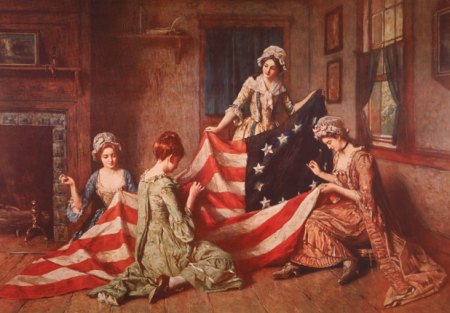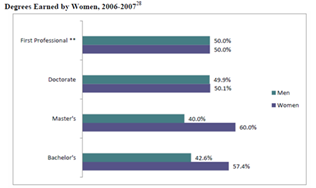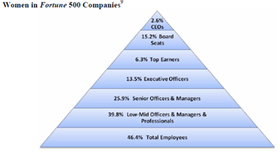In honor of National Women’s History Month 2012 and its theme of “Women’s Education – Women’s Empowerment,” I wanted to write about a thought-provoking publication that just came across my desk about women and their evolving role in the U.S. workforce. Since the founding of America, women like Betsy Ross have played a critical role in contributing to the economic fabric of the U.S. economy and American households.
Image: Sewing circle presided by working mother Betsy Ross, who started out as first a home sewer before being educated as an upholstery apprentice. She then ran an upholstery business with her husband, before managing her own business when her husband died by sewing tents, blankets and flags for the American Revolution.
 “Invest in Women, Invest in America: A Comprehensive Review of Women in the U.S. Economy” was prepared by the Joint Economic Committee of Congress.
“Invest in Women, Invest in America: A Comprehensive Review of Women in the U.S. Economy” was prepared by the Joint Economic Committee of Congress.
It forms part of GPO’s Online Bookstore National Women’s History Month collection of Government publications celebrating women’s contributions to America.
Outgoing Chair of the Committee, Congresswoman Carolyn B. Maloney, said in a December 2010 letter that the goal was to prepare a “comprehensive review of women in the U.S. economy so that policymakers could have a better understanding of women’s essential contributions to our economy and their potential to play a stronger role in our economic recovery.”
PART I: Invest in Women, Invest in America
Part I of this publication starts with an overview of the decades of progress of women in the workforce. For the first time, we learn that women now comprise half of the U.S. workforce.
Next, relating to this month’s theme of education providing empowerment for women, the report shows that women earn more college degrees than men at every level, from 57.4% of the bachelor’s degrees to over 60% of the Master’s degrees in the United States.
And it demonstrates just how important women’s earnings have become to overall household income, particularly in families with children. For example, by 2008 over 6 in 10 families with children under 6 have the mother working outside the home, and women are the sole job-holders in over a third of American families with children.
The “Invest in Women” publication discusses the three key factors that are still holding women back, including:
- underrepresentation in business leadership roles,
- a “persistent gender wage gap” in both public and private sectors, and
- an “out-of-date framework for social support.”
Factor 1: Underrepresentation of Women in the Executive Suite
Under this factor, the report puts forth both current figures and possible causes about why “women remain dramatically underrepresented in corporate boardrooms and executive suites” in the United States. Some figures shared in the report show that while women comprise 46.4% of all Fortune 500 employees, they make up just 15.7% of board seats, 14.4% of executive officers, 7.6% of top earning executive officers, and only 2.4% of CEOs.
This contrasts to studies included in the report that demonstrated that “companies with more women board members, on average, significantly outperform those with fewer women by 53% on Return on Equity, 42% on Return on Sales, and a whopping 66% of Return on Invested Capital.”
Factor 2: Persistent Gender Wage Gap
In the private sector, “Invest in Women” reports, “women working full-time earn only 77 cents for every dollar earned by men”— a gap the report says has not improved since 2001. This wage gap is true also for the Federal Government where “women managers earn 81 cents for every dollar earned by their male manager peers”.
Source: Women’s Media
Factor 3: An Out-Of-Date Framework for Social Support
Here the report offers the premise that “our nation’s public policies are still rooted in the antiquated assumption that families rely on a single male breadwinner” when today’s “reality is that most families depend on two breadwinners.” Discussion of the issues relating to lack of paid leave, particularly sick leave and the burden it places on mothers who often “still bear the primary responsibility for their children’s health” are followed by sections on inflexible work arrangements and insufficient “quality, affordable early care and education.”
This ends with an interesting analysis of the nation’s current retirement system and its effect on women. The report points out the lifetime earnings penalty—caused by the many interruptions over the span of a woman’s career to provide unpaid at-home care for children, elderly parents or ill family members— results in vastly decreased Social Security income for women, thus increasing women’s poverty rates later in life at a rate of 11.7% vs. 7.4% for elderly men.
Possible Policy Solutions to Improve Women’s Economic Position
Some possible policy solutions are put forward in this report as well, including:
- “Stronger protections against wage discrimination;”
- “Health reform;”
- “Work-family policies” (including the right to request a flexible schedule and mandatory paid sick leave);
- Financial regulatory reform and the “establishment of Offices of Minority and Women Inclusion at each federal financial services agency;”
- “Value the Care Economy”, which, according to the authors, refers to boosting investment in quality early education and child care programs, such as Early Head Start and Head Start; and
- Differentiating the impact of tax and entitlement reforms on women versus on men.
Part II: Compendium of JEC Reports and Hearings from the 111th Congress
The second part of the publication compiles various reports and hearings held by the Joint Economic Committee that referred to women’s issues covering four areas: Women in the Economy Today, Equal Pay, Access to Benefits and Retirement Security.
It is chock full of charts, tables, graphs and quotable quotes.
HOW DO I OBTAIN “Invest in Women, Invest in America: A Comprehensive Review of Women in the U.S. Economy”?
- Buy it online 24/7 at GPO’s Online Bookstore.
- Buy it at GPO’s retail bookstore at 710 North Capitol Street NW, Washington, DC 20401, open Monday-Friday, 9am to 4pm, except Federal holidays, (202) 512-0132.
- Find it in a library.
About the Author: Michele Bartram is Promotions Manager for GPO’s Publication and Information Sales Division and is responsible for online and offline marketing of the US Government Online Bookstore (Bookstore.gpo.gov) and promoting Federal government content to the public.








Equality and the point of family coming together and living together as a family. That is what it’s all about and times haven’t changed. I enjoyed this article. It was helpful. Keep on posting!|
LikeLike
I really like looking through a post that can make men and women think.
Also, thanks for allowing for me to comment!
LikeLike
Equality and the point of family coming together and living together as a family. That is what it’s all about and times haven’t changed.
LikeLike
What is the actual name of the photo of sewing circle and who painted it?
LikeLike
Nef: The painting is called “Birth of the Flag” and is by painter Henry Mosler (1841-1920).
LikeLike
What’s up, just wanted to say, I enjoyed this article. It was helpful. Keep on posting!|
What’s up, I log on to your new stuff daily. Your story-telling style is awesome, keep doing what you’re doing!|
I just couldn’t leave your website before suggesting that I actually enjoyed the standard info a person supply on your guests? Is gonna be back incessantly to inspect new posts|
Hi there, I enjoy reading through your article post.
LikeLike
more facebook fans…
[…]Invest in Women, Invest in America « Government Book Talk[…]…
LikeLike
links are good…
[…]check below, are some totally unrelated websites to ours, nonetheless, they’re most trustworthy sources that we use[…]…
LikeLike
I know you’ll want spent lote of your time for this write-up.At any rate, I truly get pleasure from reading your posts.
LikeLike
How does economic policy/globalization effect poverty and inequality in Brazil?
LikeLike
Hello Website Owner! Very nice blog you have here, I kinda like it! I noticed you were using WordPress and I figure I’d share a tip with you. There’s a plugin for WordPress I use on my own websites that will help you boost your traffic significantly ! You can easily get a spot on the page 1 for your specific keywords ! Here is the link … http://bit.ly/xqj97z ! If you need help with anything feel free to contact me ! Have a nice day !
LikeLike
I enjoyed your wonderful words. brilliant stuff. I hope you produce others. I will continue watching
LikeLike
Thanks for the compliment!
LikeLike